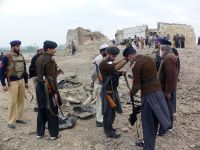Five years after the Arab uprisings: an interview with Asef Bayat
If we look carefully to all of these experiences, all of the protests, including those in Libya, Syria, and Yemen, they were at first remarkably peaceful and civil. In both Syria and Libya, the regimes’ reaction was brutal and extraordinary. The protests suffered a lot of casualties, but they were still non-violent until the foreign forces got involved: NATO and Qatar in Libya and a host of countries ranging from Saudi Arabia, Turkey, and the Unites States to Iran, Hezbullah, al-Qaeda and then Russia. Their involvement militarized the bulk of the uprisings, turning these countries into a theatrical stage for settling geopolitical accounts. It is remarkable that despite the brutality and violence by the regime and the armed opposition, the ordinary Syrians have shown that they still wish to protest peacefully when opportunities arise as we have seen in recent episodes.
Continue reading on Jadaliyya
Baghdad graffiti
The graffiti I put up was on a wall outside our house in Baghdad. It was a skull and bones. Patrolling American troops saw it as a threat. They came to the house, searched it, and took pictures of everyone living there. I guess it was my first public exhibition.
The war took so much from my family. I was young, but I remember all the horrors. I remember how, during the height of the sectarian war, my cousin Hussein went to work, selling gas canisters, and never came back home. I remember how, one day, we would hear voices shouting, “Set it up here, right here,” right outside our living room window. As we moved the curtains aside to see what was happening, we saw militia men setting up a rocket grenade launcher unveil itself.
Continue reading on Shako Mako
Armenian artisans of the Grand Bazaar
For years, Istanbul’s Grand Bazaar disappointed me. I was unimpressed with its quasi-authentic shops selling factory-made Turkish delight, Made-in-China pashminas, belly-dancer outfits and kitsch stained-glass lamps.
I wanted to time-travel back to the bazaar that Italian novelist Edmondo De Amicis described in 1877, a place where “every shop door is the frame of a picture full of colour and romance.” I wanted to see the narrow stalls that were more like cupboards than spaces where you could comfortably enter and browse. I wanted to sit on street divans and drink coffee with the Turkish, Armenian, Jewish and Greek shopkeepers. I wanted to watch artisans toil away inside tiny ateliers. But, so I thought, none of that would be possible in a place where the only thing resembling a renowned Ottoman market were the arches overhead.
Continue reading on Mashallah News







